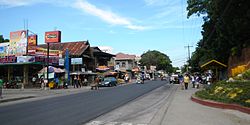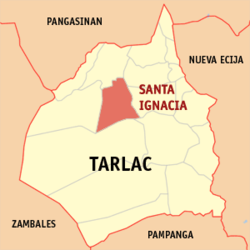Santa Ignacia Last updated December 22, 2025 Municipality in Tarlac, Philippines
Municipality in Central Luzon, Philippines
Santa Ignacia , officially the Municipality of Santa Ignacia (Pangasinan : Baley na Santa Ignacia Ilocano : Ili ti Santa Ignacia Tagalog : Bayan ng Santa Ignacia municipality in the province of Tarlac , Philippines . According to the 2024 census , it has a population of 53,620 people. [ 5]
Geography Santa Ignacia is 26 kilometres (16 mi) from provincial capital Tarlac City , 150 kilometres (93 mi) from Manila , and 10 kilometres (6.2 mi) from Camiling .
Santa Ignacia has a total land area of 14,607 hectares (36,095 acres) .
Barangays Santa Ignacia is politically subdivided into 24 barangays , as shown below. [ 6] Each barangay consists of puroks and some have sitios .
There are two barangays (highlighted in bold ) which considered as urban while the rest of 22 barangays are rural.
Baldios Botbotones Caanamongan Cabaruan Cabugbugan Caduldulaoan Calipayan Macaguing Nambalan Padapada Pilpila Pinpinas Poblacion East Poblacion West Pugo-Cecilio San Francisco San Sotero San Vicente Santa Ines Centro Santa Ines East Santa Ines West Taguiporo Timmaguab Vargas Climate Climate data for Santa Ignacia, Tarlac Month Jan Feb Mar Apr May Jun Jul Aug Sep Oct Nov Dec Year Mean daily maximum °C (°F) 30 31 33 35 33 31 30 29 29 30 31 30 31 Mean daily minimum °C (°F) 19 19 20 22 24 24 24 24 23 22 21 20 22 Average precipitation mm (inches) 3 2 5 10 80 107 138 147 119 70 26 8 715 Average rainy days 2.0 1.7 2.7 4.6 16.1 20.8 24.0 23.0 21.4 15.5 8.0 3.2 143 Source: Meteoblue [ 7]
Demographics Population census of Santa Ignacia Year ±% p.a. 1903 1,911 — 1918 5,382 +7.15% 1939 10,993 +3.46% 1948 14,061 +2.77% 1960 15,512 +0.82% 1970 20,775 +2.96% 1975 23,157 +2.20% 1980 25,224 +1.72% 1990 30,470 +1.91% 1995 34,658 +2.44% 2000 38,301 +2.17% 2007 43,560 +1.79% 2010 43,787 +0.19% 2015 47,538 +1.58% 2020 51,626 +1.75% 2024 53,620 +0.91% Source: Philippine Statistics Authority [ 8] [ 9] [ 10] [ 11] [ 12]
In the 2020 census, the population of Santa Ignacia, Tarlac, was 51,626 people, [ 13] with a density of 350 inhabitants per square kilometre or 910 inhabitants per square mile .
Education The Santa Ignacia Schools District Office governs all educational institutions within the municipality. It oversees the management and operations of all private and public, from primary to secondary schools. [ 22]
Primary and elementary schools Accelerated Learning Academy Botbotones Elementary School Caanamongan Elementary School Cabugbugan Elementary School Caduldulaoan Elementary School Calipayan Elementary School Don Bonifacio Alviar Elementary School Macaguing Primary School Nambalan Elementary School Padapada United Methodist Church Learning Center Pilpila Elementary School Pinpinas Elementary School Pugo Cecilio Elementary School San Francisco Elementary School San Sotero Elementary School San Vicente Elementary School Schola Christi Montessori SIBC Christian Academy Siena Montessori School Sta. Ignacia Academy Sta. Ignacia Catholic School Sta. Ignacia Educational Institution Sta. Ignacia North Central School Sta. Ignacia South Cemtral Elementary School Sta. Ignacia United Methodist Church Learning Center Sta. Ines Central Elementary School Sta. Ines East Elementary School Sta. Ines West Elementary School Sta. Ines West Primary School (Annex) Taguiporo-Cabaruan Elementary School Timmaguab Elementary School Vargas Elementary School Secondary schools Caanamongan High School Calipayan National High School Nambalan National High School Padapada National High School Pilpila High School Sacata National High School Sta. Ignacia Academy Sta. Ignacia High School Sta. Ignacia National High School Sta. Ines National High School Vargas High School Higher educational institution Glory Dei Montessori College References ↑ Municipality of Santa Ignacia | (DILG) ↑ "2015 Census of Population, Report No. 3 – Population, Land Area, and Population Density" (PDF) . Philippine Statistics Authority . Quezon City, Philippines. August 2016. ISSN 0117-1453 . Archived (PDF) from the original on May 25, 2021. Retrieved July 16, 2021 . ↑ "2024 Census of Population (POPCEN) Population Counts Declared Official by the President" . Philippine Statistics Authority. 17 July 2025. Retrieved 18 July 2025 . ↑ "PSA Releases the 2021 City and Municipal Level Poverty Estimates" . Philippine Statistics Authority. 2 April 2024. Retrieved 28 April 2024 . ↑ "2024 Census of Population (POPCEN) Population Counts Declared Official by the President" . Philippine Statistics Authority. 17 July 2025. Retrieved 18 July 2025 . ↑ "Province:" . PSGC Interactive . Quezon City, Philippines: Philippine Statistics Authority . Retrieved 25 August 2025 . ↑ "Santa Ignacia: Average Temperatures and Rainfall" . Meteoblue. Retrieved 5 May 2020 . ↑ "2024 Census of Population (POPCEN) Population Counts Declared Official by the President" . Philippine Statistics Authority. 17 July 2025. Retrieved 18 July 2025 . ↑ Census of Population (2015). "Region III (Central Luzon)" . Total Population by Province, City, Municipality and Barangay . Philippine Statistics Authority . Retrieved 20 June 2016 . ↑ Census of Population and Housing (2010). "Region III (Central Luzon)" (PDF) . Total Population by Province, City, Municipality and Barangay . National Statistics Office . Retrieved 29 June 2016 . ↑ Censuses of Population (1903–2007). "Region III (Central Luzon)" . Table 1. Population Enumerated in Various Censuses by Province/Highly Urbanized City: 1903 to 2007 National Statistics Office . ↑ "Province of" . Municipality Population Data . Local Water Utilities Administration Research Division. Retrieved 17 December 2016 . ↑ "2024 Census of Population (POPCEN) Population Counts Declared Official by the President" . Philippine Statistics Authority. 17 July 2025. Retrieved 18 July 2025 . ↑ "Poverty incidence (PI):" . Philippine Statistics Authority. Retrieved December 28, 2020 . ↑ "Estimation of Local Poverty in the Philippines" (PDF) . Philippine Statistics Authority. 29 November 2005. ↑ "2003 City and Municipal Level Poverty Estimates" (PDF) . Philippine Statistics Authority. 23 March 2009. ↑ "City and Municipal Level Poverty Estimates; 2006 and 2009" (PDF) . Philippine Statistics Authority. 3 August 2012. ↑ "2012 Municipal and City Level Poverty Estimates" (PDF) . Philippine Statistics Authority. 31 May 2016. ↑ "Municipal and City Level Small Area Poverty Estimates; 2009, 2012 and 2015" . Philippine Statistics Authority. 10 July 2019. ↑ "PSA Releases the 2018 Municipal and City Level Poverty Estimates" . Philippine Statistics Authority. 15 December 2021. Retrieved 22 January 2022 . ↑ "PSA Releases the 2021 City and Municipal Level Poverty Estimates" . Philippine Statistics Authority. 2 April 2024. Retrieved 28 April 2024 . ↑ "Masterlist of Schools" (PDF) . Department of Education . January 15, 2021. Retrieved September 24, 2025 . External links
Places adjacent to Santa Ignacia
This page is based on this
Wikipedia article Text is available under the
CC BY-SA 4.0 license; additional terms may apply.
Images, videos and audio are available under their respective licenses.








